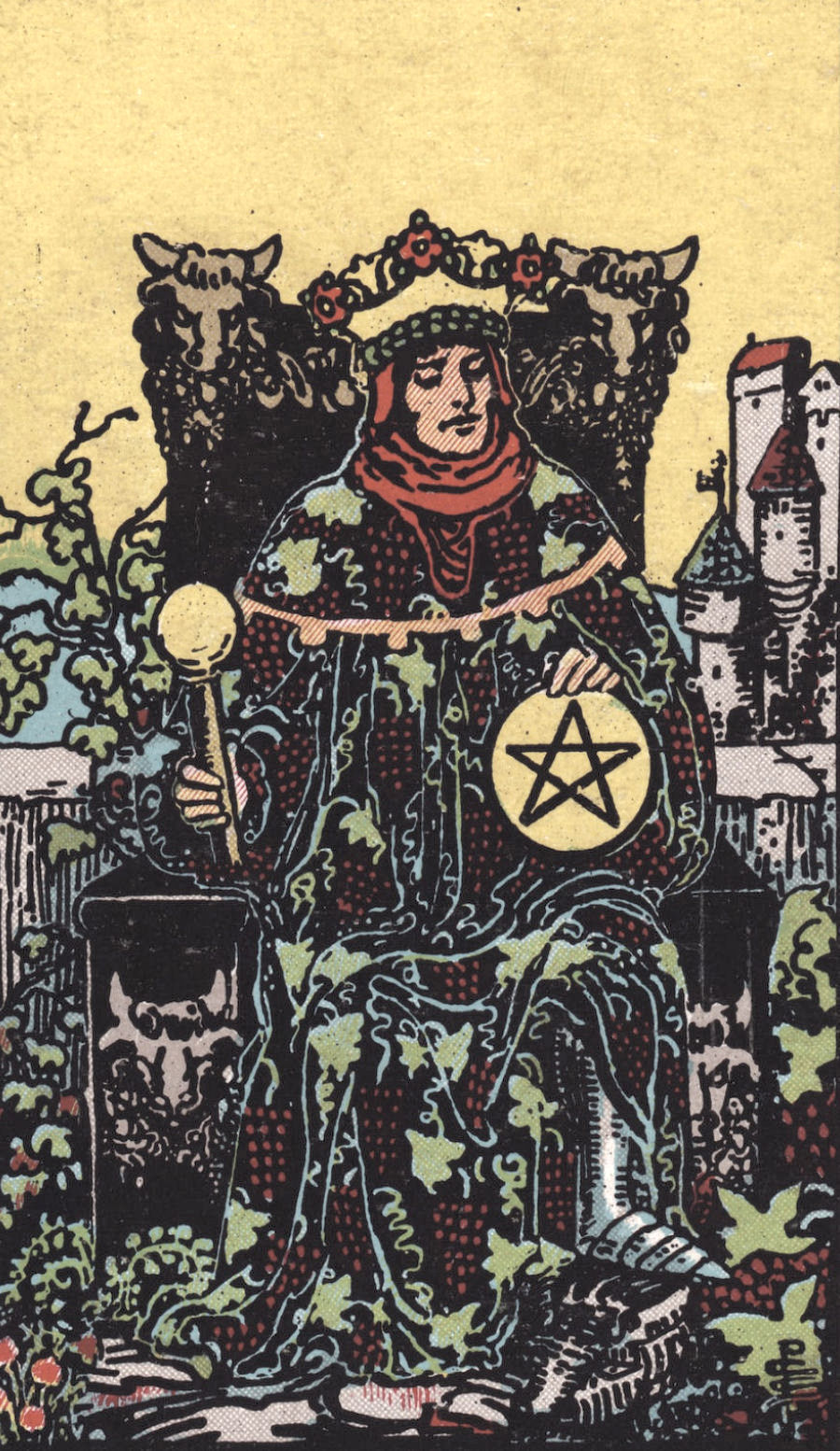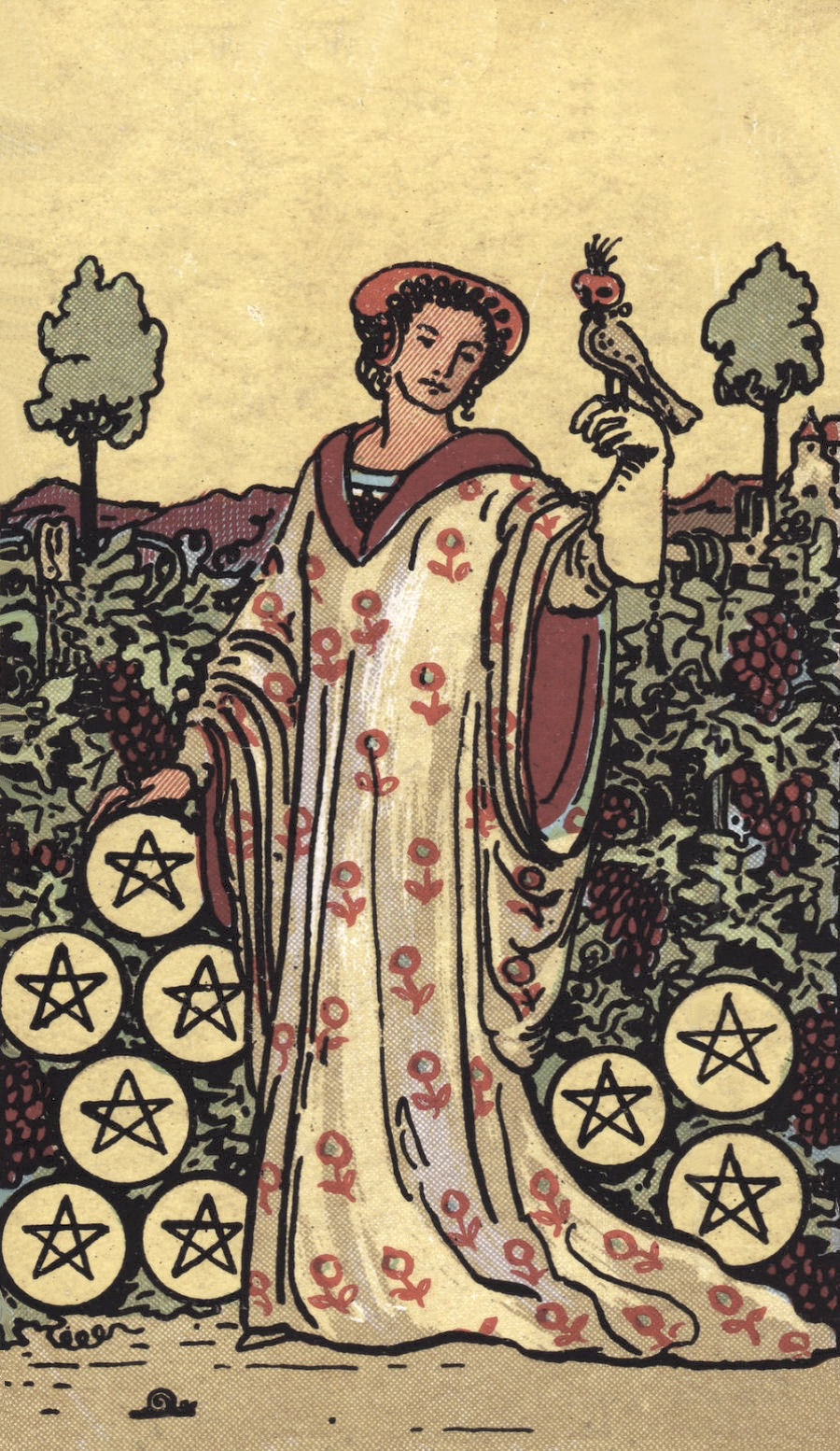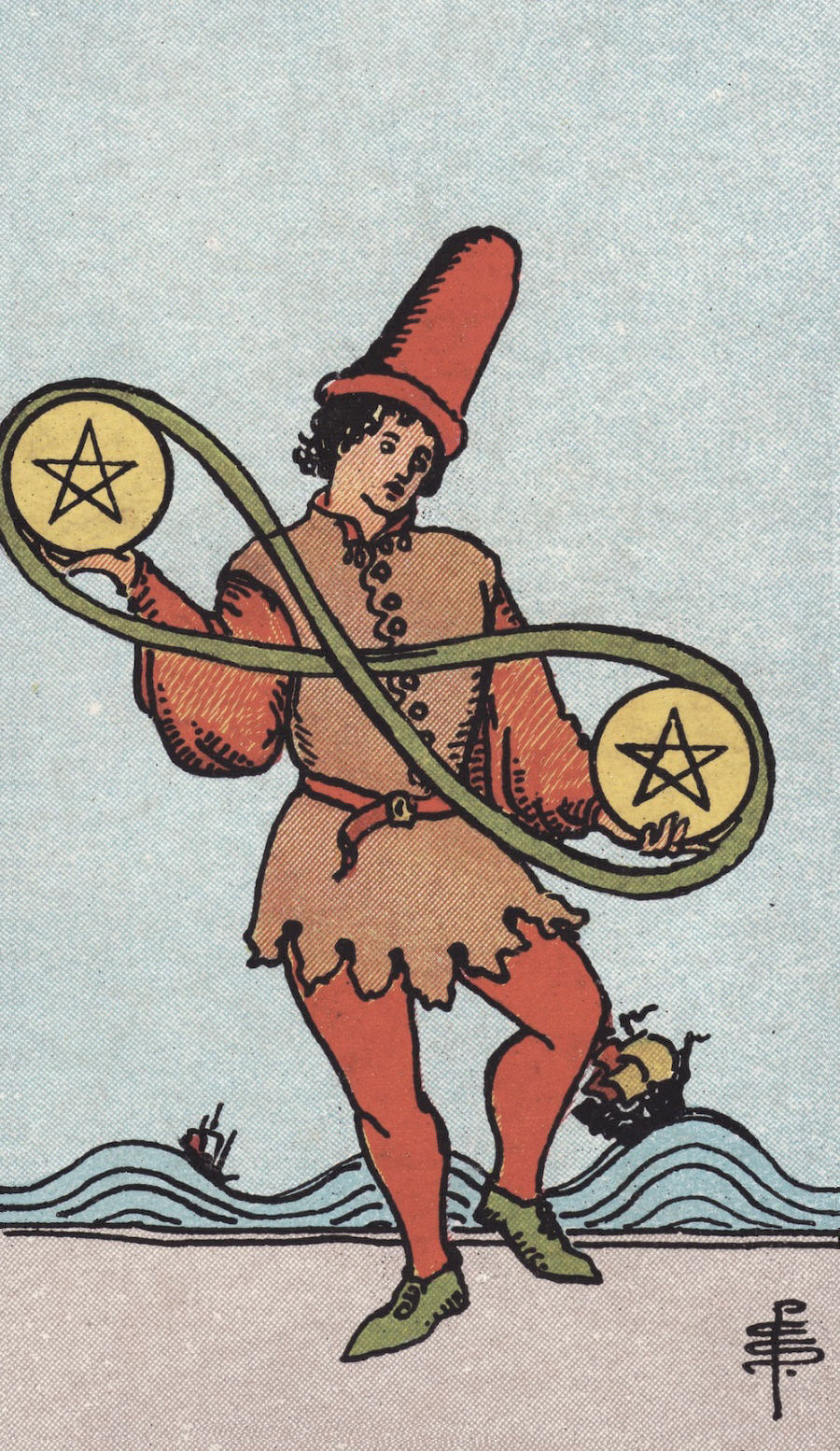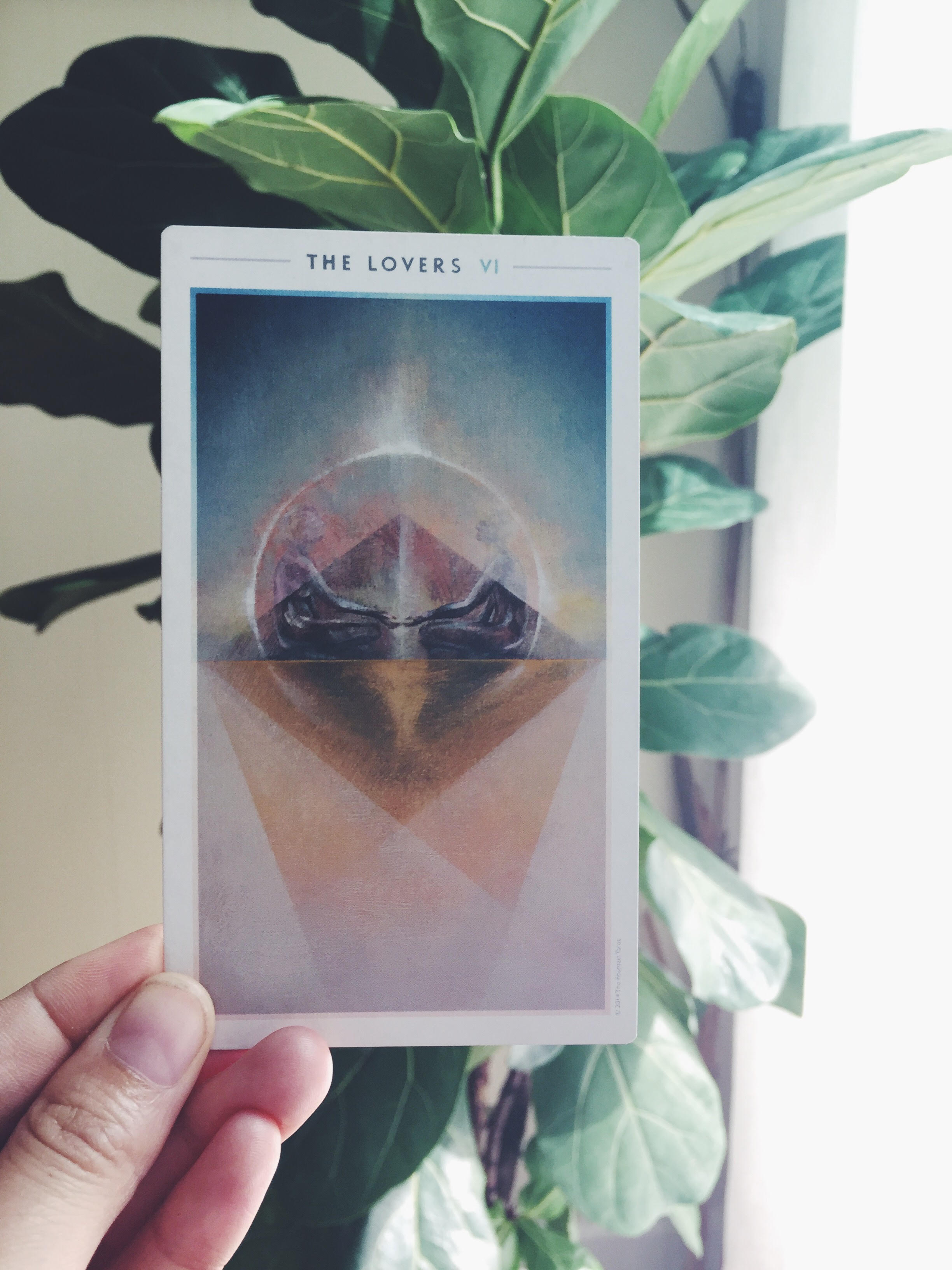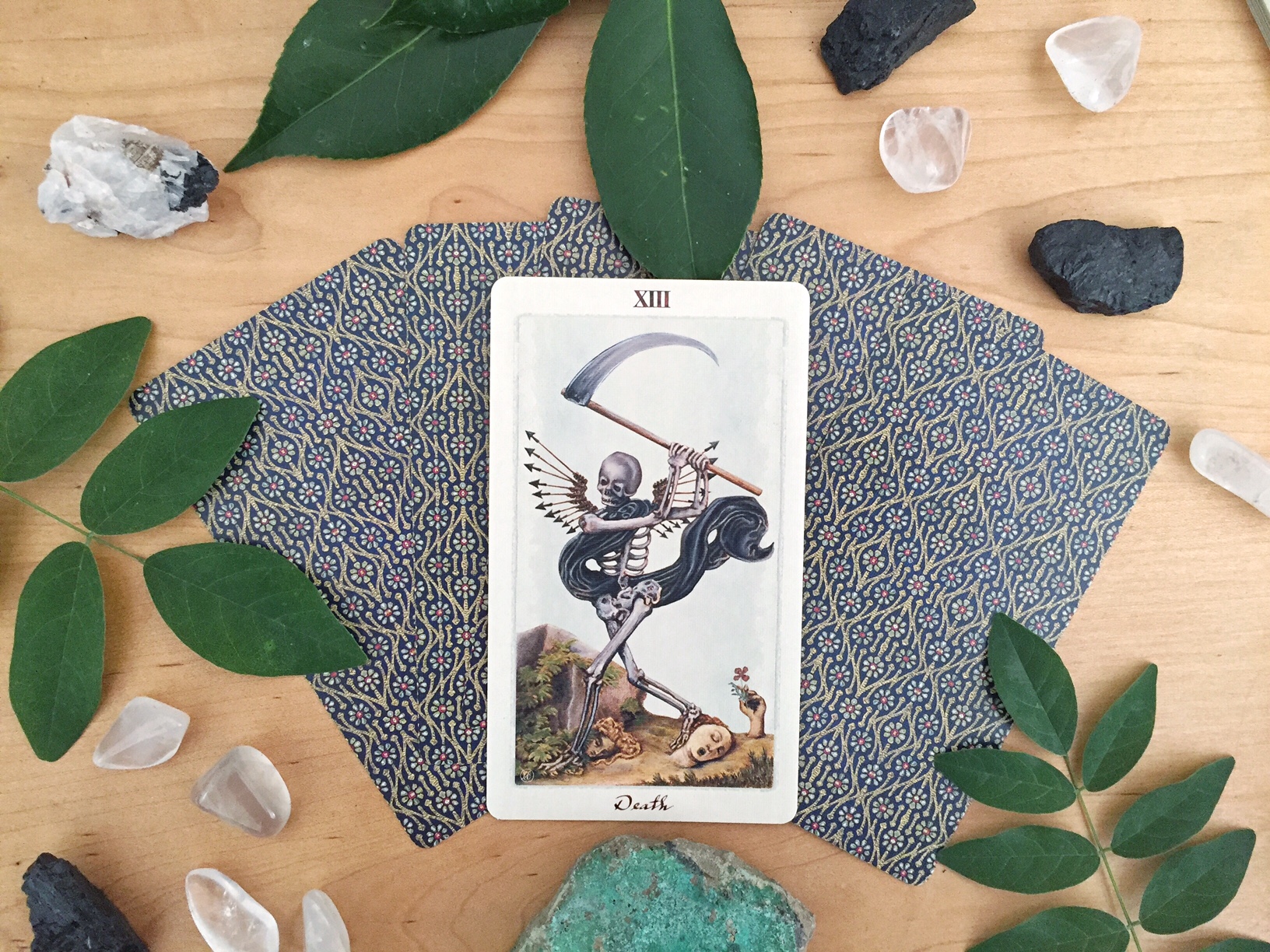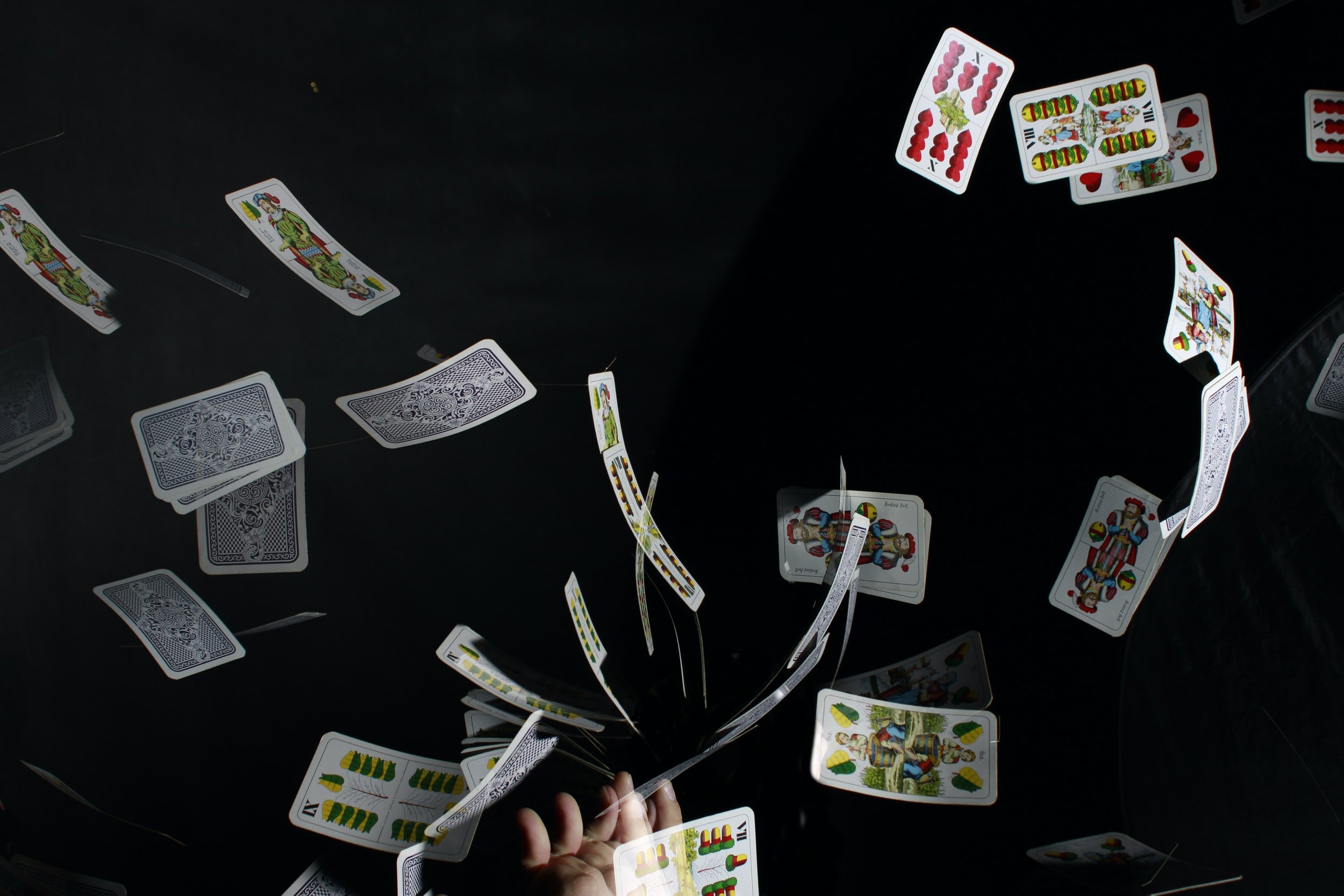Finding Joy in Work with the Two of Pentacles
I woke up this morning wanting to spend some time in the Incandescent Tarot universe. I’ve been in a frenzy of spring cleaning the past few days; after going hard in that domestic direction, I felt the need to change course - it’s just not fair if I let this space languish! Plus, it’s something that brings me joy.
I woke up this morning wanting to spend some time in the Incandescent Tarot universe. I’ve been in a frenzy of spring cleaning the past few days; after going hard in that domestic direction, I felt the need to change course - it’s just not fair if I let this space languish! Plus, it’s something that brings me joy.
So jaunty!
So, I sat down at a table in my local coffee shop and… decided to research new bookkeeping software? Needless to say this decision did not make me feel relaxed. Once I stopped and decided to refocus on the fun part (writing) I was all flustered and confused. I lost my zest and excitement.
Suddenly, “More Than This” by Roxy Music started playing in my headphones. Now this is a song that never ceases to delight me. I found myself grinning and swaying in my seat (and likely alarming my fellow patrons). My mood had officially shifted.
And that’s when I got the idea to write this post.
I love how the Two of Pentacles takes the practical nature of the pentacles and infuses it with the energetic, lighthearted energy of the twos. A low number in the suit, this two shows us how following our energy and staying in the moment yields the best (and most enjoyable) results. It doesn’t have to be a serious slog or ambitious reach. Our work can be dynamic and satisfying when we keep things simple.
Achieving this state can be as simple as allowing ourselves to do the fun, small things first. Or, if we’ve made a detour to stress-land like I did with my ill-advised bookkeeping research, we can use something uplifting to reinvigorate ourselves: a song, quick walk outside, or some other type of treat.
Check it Out: Robert Place on Tarot as a Spiritual Path
I’ve been thinking a lot lately about tarot and its many uses, particularly how to sum up my personal approach. As a tarot reader and teacher, I get asked this question a lot. And, as a spiritual seeker, my experience and outlook changes subtly over time.
One of the major shifts has been around the idea of spirituality. As a cynical child from a very secular family, I has an almost allergic response to the term. To me, spirituality meant flighty, irrational, and hopelessly outdated.
I’ve been thinking a lot lately about tarot and its many uses, particularly how to sum up my personal approach. As a tarot reader and teacher, I get asked this question a lot. And, as a spiritual seeker, my experience and outlook changes subtly over time.
One of the major shifts has been around the idea of spirituality. As a cynical child from a very secular family, I has an almost allergic response to the term. To me, spirituality meant flighty, irrational, and hopelessly outdated.
As any of you who’ve been following my work likely know, I was living a huge contradiction: My orientation towards the world, at least privately, was deeply spiritual. I saw the world as a living place, practiced free-form rituals as a young child, and even though I’d never admit it, found deep insight in the tarot.
Perhaps because I didn’t grow up in a religious tradition, I was unaware of the natural, human pursuit of spiritual meaning. To have other people to talk to about these questions and experiences would be delightful! But like any isolated and underexposed child, I thought I was completely alone.
So imagine my surprise when I learned more about what spirituality actually is and found I was already doing it, loving it, and finditing it deeply meaningful!
Which brings us to this article I’d like to share. I shouldn’t be surprised that Robert Place would be the person to so perfectly articulate tarot’s connection to spiritual practice. A renowned and wonderfully reliable scholar of tarot and divination, Place distills these ideas expertly in this interview with Buddha Weekly. He touches on the differences between divination and fortune telling (a key point!) and how to use tarot as a spiritual path.
I particularly love this quote:
“It is better to ask about relationships with other people or about routine decisions that need to be made. You want the Tarot to tell you things that may be hard to hear, about how you are being self-centered or short sighted. And then you want the Higher Self to show you a better way to behave. As you practice this day-to-day and act on the advice, you are making better decisions and becoming more like your Higher Self. This process becomes a spiritual path.”
Check out the interview here and share your thoughts in the comments below. How do you view tarot’s connection with spiritual practice? What has your personal experience been?
Reclaiming Sensuality with The Pentacles
The Pentacles often get a bad rap. Pigeonholed into matters of finance and career (they are also called coins, after all) these cards quickly become stagnant and stale. Where’s the romance? The passion? The adventure?
Yet the Pentacles have a hidden side, on that’s not always brought to light in tarot books. You might be surprised to hear that, of all the suits, I see the Pentacles as the most erotic of the bunch.
The Pentacles often get a bad rap. Pigeonholed into matters of finance and career (they are also called coins, after all) these cards quickly become stagnant and stale. Where’s the romance? The passion? The adventure?
Yet the Pentacles have a hidden side, on that’s not always brought to light in tarot books. You might be surprised to hear that, of all the suits, I see the Pentacles as the most erotic of the bunch.
“What?” you might say. “Not the phallic wands or juicy cups?!” (Note: I strongly doubt anyone would peg the analytical swords as lush romantics! Sorry, swords.)
To get into my mindset, it’s important to remember that Pentacles are associated with the element of earth. It governs the everyday, the material… the physical. And how do we engage with the physical world around us? Through our senses, our bodies, and our presence.
This means that the Pentacles govern the feeling of the wind on our faces, a lover running their fingers along our skin, the taste of a delectable fresh peach, and the smell of an intoxicating perfume. Just look at the imagery in these cards. There’s depictions of work and labor, yes, but also characters fully feeling themselves.
Take the King of Pentacles and the Nine, for example:
These cards show figures unabashedly sure of themselves, luxuriating in life. Taken to the extreme, these traits can become wasteful, but at just the right level they acquaint us with our true power, presence, and capacity for pleasure.
Becoming aligned with our physical self aligns us with our connection to the world around us. What does this feel like? What does my body have to say? What feels good to me and what makes the people around us feel good?
How can we be aware and take joy in the riches around us if we’re not aware of the riches in ourselves and our bodies?
I see this group of cards as an invitation to take our pleasure seriously as well as to look for pleasure all around us. It doesn’t have to be through sexual eroticism alone. There’s plenty of sensuality in all aspects of life and, as these cards demonstrate, tapping into it makes life so much more lush, joyful, and satisfying.
Migraines & The Tower
A few days ago I was watching TV with my husband (why yes, it was the Fyre Festival documentary - why can’t I get enough of that trainwreck?) when I noticed an odd shimmer at the corner of my eye. It was late at night, so I figured I was just tired. But it suck around, following me wherever I looked, and a sinking feeling in my stomach took over. I knew what this was: a migraine.
A few days ago I was watching TV with my husband (why yes, it was the Fyre Festival documentary - why can’t I get enough of that trainwreck?) when I noticed an odd shimmer at the corner of my eye. It was late at night, so I figured I was just tired. But it suck around, following me wherever I looked, and a sinking feeling in my stomach took over. I knew what this was: a migraine.
I’ve been getting migraines since college and, while the debilitating pain has decreased over the years, I still get the full-blown aura effect, followed by days of disorientation, fatigue, and a throbbing, persistent headache. Over the next 24-hours I had four episodes, the most in recent memory. Clearly, my plans for the next few days would have to be put on the backburner.
I pulled the blinds, popped a few painkillers, and settled in for the long-haul.
When I first started getting these headaches I was massively upset by them. There’s no way around it: they’re really and truly terrible. I had never experienced a health issue that completely incapacitated me before. Sick days? Who needs them! Time off? No thank you, I’ll just keep going!
Well, that was certainly the old Gina. I prided myself in being a person who kept going no matter what. Migraines forced me to see the limits to my strength and accept my helplessness in the face of physical suffering. I simply couldn’t function when half my vision was a blurred mess and my head hurt so much I had to bite my pillow.
In many ways migraines are like The Tower. I’m even laughing a little as I type this because it works so well and I’ve never thought of it until now. You have the jagged bolt of lightning (the headache!) striking the top of the tower (the head!), sending the body crashing to the ground along with its two inhabitants.
The image perfectly captures the terror when something outside of our control wreaks havoc on our lives. It’s jarring, upsetting, and abrupt.
And what’s more, despite all our planning, the goals and aspirations of our conscious mind are helpless in the face of intense physical suffering.
And, hoo boy, does this mess with our deeply entrenched ideas of productivity and self-worth!
Like The Tower, this process is not at all dignified, at least in my experience. I raged against my physical limitations at first, trying to push through the issue. The migraine won. I let myself get consumed with guilt: who am I if I can’t do things? Don’t I have to constantly be proving my worth? The migraine still won.
And, oddly enough, once the dust settled the only thing to really crumble were these stale thoughts. My health recovers as does my ability to be productive. The only difference is that I’ve been forced to see my true vulnerability and accept that so much of life is outside my control.
Through my experiences with migraines I’ve realized that I don’t have to go around making things happen in my life through sheer force, much like old Atlas holding the world on my shoulders. Things go along fine without me and people still love me without having to prove my worth. I can be a quivering blob for a few days and everything’s still okay. My only job, then, is to just be there for myself - to be present in the fall from The Tower with all the gentleness and acceptance I can muster. After all, I can’t do anything to change what’s happening, but I sure can make it more pleasant for myself by focusing on the reality of the situation instead of fighting against it.
So this time I sighed and let the whole experience take its course. I set aside my long to-do list and simply rested, trusting that I’d be back to my healthy self soon enough. And while it wasn’t ideal and certainly didn’t feel pleasant, I was grateful for the opportunity to just be there for myself: to feel my body, care for myself in the most basic ways (lots of water, a warm shower), and let my support network step up.
Now, on the other end, I feel oddly refreshed. My Tower experience hasn’t brought down my entire world, rather it’s reminded me of how delicate and special it is. With this newfound appreciation I feel eager to ease back into things and motivated to balance my energy with plenty of rest and gentleness, no lightning bolt required.
Some questions for working with The Tower
What change outside of my control is frightening me?
How can I be present for myself during this experience?
What control am I afraid of losing?
What’s the worst that can happen? Is is really happening?
How do I actually feel right now?
What kindness & softness can I give to myself right now? How can I reach out to others?
The Nine of Pentacles & Marie Kondo
I wasn’t planning on writing about the KonMari method - the tidying phenomenon created by Marie Kondo that’s sweeping the nation for a second time via her new Netflix show . In fact, I intentionally avoided it, thinking it would be too topical and click-bait-y.
*not an actual representation of my rainbow organization skills*
I wasn’t planning on writing about the KonMari method - the tidying phenomenon created by Marie Kondo that’s sweeping the nation for a second time via her new Netflix show . In fact, I intentionally avoided it, thinking it would be too topical and click-bait-y.
But yesterday I was inspired to venture into my overstuffed closet and do some purging. After using Kondo’s technique, holding (or in my case, trying on) each item and determining whether it “sparks joy,” I came to some interesting realizations that synced up with the tarot and I just had to share it here.
One of my cards of the year is the Nine of Pentacles which I selected because I’m feeling called to take my finances seriously and dive deep into how and where I cheat myself out of feeling abundance. I, too, want to stand in a lush garden of glowing coins in a fantastic robe!
And as I started trying on my existing collection of “robes,” I was surprised to discover some unlikely candidates for “most authentic & joyful Gina uniforms.” What made me feel lush and competent like the Nine of Pentacles?
In a practical sense, it’s fun & punchy day dresses. But there’s one item that truly makes me feel decadent and powerful: insanely puffy 1950s cupcake ball gowns.
Over the years I’ve collected several, but usually with intense guilt. Where on earth was I going to wear these? In all my closet cleansings I go through the tortured motions of deciding to sell them. “It would be the fiscally responsible thing to do,” I tell myself, nevermind the fact that this is probably the only time I ever use the bloodcurdling (to me) phrase “fiscally responsible.”
And this time as I tried on the dresses I thought, “Wow, this makes me feel so incredibly amazing, it costs less than a pair of new shoes, and just looking at it makes me euphoric.” In other words, they sparks some serious, next-level joy.
Here’s where the Nine of Pentacles comes in, lest you think I’m running away on a passionate affair with tiered chiffon. In this card we see a figure clearly in touch with their ability to provide for themselves. They can see all their pentacles/coins and relish in their presence. They have enough and dress the part. There’s no guilt or shame or intense constriction (point of comparison: the Four of Pentacles).
In this card, we can see that being aware of your resources, celebrating them responsibly, and using them to express yourself leads to increased abundance. Our money should work for us, lift us up, and allow us to access meaningful experiences.
This brings us to my favorite symbol in the card: the hooded falcon perched on the main figure’s hand. It symbolizes our animal nature, the part of us that can get unruly, rebellious, and likes to follow its instincts unchecked, wherever they may lead.
In this card, however, the falcon has been trained. It sits calmly, ready to fly off at its owners bidding. Getting to this point takes patience, understanding, and a desire to look deep into ourselves. In my free-flying falcon days I may have spent a little too much on outlandish vintage dresses. Now, however, I know my weaknesses and have worked hard to tame them. I’ve directed my energy towards growing a garden and it’s providing enough to feel cozy an secure.
This is the time to send the falcon off on the mission or, in other words, let yourself enjoy some of the fruits of your labor, but do so in the service of your growth and abundance. So, in my case, allowing myself something that sparks joy in small doses - a cupcake dress every once in a blue moon - feathers my nest and gives me so much: inspiration, self-expression, and my own personal love of outlandish fantasy. All without running myself into debt or detracting from my larger goals.
It’s good to have a little wildness, especially when we can harness it to do our bidding.
Is There Such a Thing as "The Wrong Choice"?
What to do? This a question we ask ourselves so often that many of the decisions we make become reflexive, dictated by our subconscious. What type of toothpaste should I buy? Wake up or hit snooze again? We've made hundreds of these little choices before the day is done.
And then there's another type of choice. The big ones. Move for a new job or stay in our current position? Start a business or go back to school? Stick with a dissatisfying relationship or break things off?
What to do? This a question we ask ourselves so often that many of the decisions we make become reflexive, dictated by our subconscious. What type of toothpaste should I buy? Wake up or hit snooze again? We've made hundreds of these little choices before the day is done.
And then there's another type of choice. The big ones. Move for a new job or stay in our current position? Start a business or go back to school? Stick with a dissatisfying relationship or break things off?
These are the kind of choices that fundamentally change our lives, at least in terms of how it looks on the ground. There's no denying that finding yourself in California launching a hotdog stand is far different from trying out a tube of wintergreen toothpaste and switching back to peppermint after deciding you don't like it.
I hear a lot from people presented with big choices as a tarot reader. It's a beautiful moment to be invited into. There's a lot to consider when we're at a big crossroads, but I've also noticed a big roadblock that pops up before we can even get into the details.
Doubt.
Particularly the fearful sort and it's consistent message is this: "What if I make the wrong choice?"
Now before I go any further, I'd like to specify that I'm talking about constructive life choices, not morality. I.e. the choices I'm speaking to are not "should I launch an online trolling campaign against my annoying neighbor?" (Yes, I think that legitimately qualifies as a bad choice!) Rather, I'm speaking to whether choices are "right" or "wrong" for an individual's personal development.
So when we're faced with an important choice and notice that we're thinking of it in terms of right vs. wrong I'd like to say one thing and one thing only: It's time to back up.
Why? Because looking at choices aimed to facilitate our majestic personal growth and transformation in terms of right and wrong is opportunity-smothering, anxiety-producing fear-based thinking.
Right and wrong are big old black and white concepts. They're far too heavy to plunk on something as transformative and new (or pre-new, aka unformed). Riding alongside this pressure is the idea that whatever choice we make will be completely and utterly irrevocable. That is, once we choose a certain career or partner we're locked in forever.
This approach strips us of two important things: free-will and change. If we don't want something, we can choose to do something different. And, most importantly, things change, often for reasons outside our control.
What does tarot have to say about this? Let's take a look at the Two of Pentacles and The World.
The Two of Pentacles is an excellent antidote to our zero-sum, one-right-way thinking. Instead of these tired ideas, the Two illustrates the freedom and relief that comes from actively engaging with our options. This card shows us that there are many right choices and we can adjust our path as we take it, making changes here and there. In this blueprint, change is expected and encouraged. We can be innovators working in real-time, not paralyzed in the world of planning and what-ifs. What's more, this is a fun and hands-on approach.
Looking to the final card of the Major Arcana, The World, gives us a peek at what we're aiming for. It's fascinating that the last card of the Fool's Journey is so free and dynamic. Sometimes known as "the world dancer," this figure is gloriously nude and revelling in the world by moving through it. We don't have a rigid, "my way or the highway" card like The Emperor capping off the sequence. No, in contrast, The World shows us that our goal isn't one right way or a path paved by single, correct decisions, but a multi-faceted sense of presence wherever we are. With us at the center, all our choices lead us to the world we're meant to be in.
And we're always moving through it, deciding as we go.
When Daily Draws Just Don't Feel Right
Look around any corner of that tarot-blogosphere and you'll immediately find information about daily draws. Select a card a day, let it reveal its wisdom, guide your actions, or simply inspire you. Sounds delightful, right?
Look around any corner of that tarot-blogosphere and you'll immediately find information about daily draws. Select a card a day, let it reveal its wisdom, guide your actions, or simply inspire you. Sounds delightful, right?
Daily draws can be a lovely component to your tarot practice. I've found that some people, however, just don't resonate with this practice. And I'm one of them.
For me, reading tarot is an immersive experience. When I read for myself, I like to let the cards sit with me for longer periods of time. I might have a card sitting on my altar for months, or a reading resting on my windowsill for a week or too. I guess you could say that my tarot metabolism is slow!
Any tarot practice or exercise should affirm and nurture your relationship to the cards. That's to say, don't worry if something doesn't resonate with you. You're by no means behind the curve or neglecting your practice if you're not doing daily draws. In this culture of constant comparison, it's easy to feel less than. Don't let your tarot experiences be one of them!
Plus, there are a myriad of ways to interact with the cards regularly, regardless of whether you're physically drawing one each day or not. Simply holding past readings in your mind, looking for parallels as you go about your daily life, or seeing the cards in other people are equally enriching practices you can do whenever and wherever you'd like.
As I explored in this post, even taking a break from reading tarot can add to your skills as a reader. Tarot is a big, beautiful system for understanding the world and the ways of working with it are similarly expansive and diverse. Follow your instincts as you develop your practice. Allow for changes, experiments, and rituals. Who knows, one day daily draws might emerge as a lovely part of your pursuits.
How about you? What are your thoughts on daily draws? What are ways that you like to work with tarot?
Tarot Reflections: Diving Deep into Shadow Work with Death and The Moon
Who here loves to read articles online? I'm the first to admit that I spend a great deal of time trolling the internet for information and entertainment (ideally, mostly for *serious, productive* goals, but we all know how things go...)
Who here loves to read articles online? I'm the first to admit that I spend a great deal of time trolling the internet for information and entertainment (ideally, mostly for *serious, productive* goals, but we all know how things go...)
One of my favorite corners is Longform, an amazingly curated collection of longform journalism. Diving into another perspective makes me feel even more connected to the stunning variety of life. And it gets me out of my usual thought patterns and into the grander, more magical side of life in all its weirdness and diversity. Plus, even when I'm procrastinating I'm learning something new.
Often times, I find myself connecting what I read to tarot because, let's face it, tarot is a huge lens through which I see the world. (Side note: I highly recommend doing this as a fun tarot exercise.)
The other day I stumbled on an article about saturation divers, people who do demolition work thousands of feet under the ocean, spending weeks at a time in intensely managed and frighteningly claustrophobic living quarters designed to spare them from the crushing pressure of all that water.
They have to move slowly, exercise caution, and trust in the systems put in place to protect them. Once they've completed their time underwater, they must slowly ascend, spending days in specially pressurized capsules aboard ships to equalize.
This deliberate, risky, and ultimately rewarding process reminded me so much of a tarot reading I had this past week. In it two of my favorite cards showed up together: Death and The Moon. Both of these cards speak to the power, mystery, and risk of transitions.
When we choose to move into our personal depths in our pursuit of growth we can uncover so much. Yet at the same time we're traveling into new and occasionally heavy territory. The Moon represents the wildness of this new place. It can be both wondrous and frightening, in turns alluring and repulsive.
Some people call this process shadow work and with good reason. Looking deeper involves bringing what was in the shadows into light. Sometimes we don't like what we see, but it's part of us nonetheless. And ultimately, we're able to find positivity and transformation for these relinquished sides of ourselves. That's one of the profound transitions represented by the Death card.
Like the saturation divers working far beneath the surface of the sea, we're under a lot of pressure when we work with our shadow. That's not to say that the pressure is crippling and fearsome, but that we should acknowledge that we're working in a different realm. The same rules don't apply, as we can see in the topsy-turvy illustration of The Moon. We can't rush around recklessly. We have to exercise caution. Move slowly. Be aware that we're doing something important.
We also can't rush to the surface quickly. Doing shadow work involves taking time apart, moving slowly with awareness of the importance of our undertaking, and giving ourselves plenty of space to ease into the bustle of life. We need TLC, in other words, when we're going to these big places. It's easy to forget this and bop right back into our routines. Doing extra self-care in these situations is always a wise investment.
What's more, we can also rely on the support network in place. While we're at the bottom of our personal sea exploring, mending, and shining a light on neglected places, we also have a connection to the people who have our back on the surface. Communicating with them about our needs, feelings, and experiences, can be a beautiful lifeline during big moments of personal growth.
So if you're in the midst of a big internal change a la Death, remember that this is a delicate, important, and beautiful process. Think like a diver at the bottom of the sea - how can you bring your awareness to these new surroundings. What different ways must you move? How can you give yourself time and space to process, recalibrate, and equalize?
Diving deep can be hard work. But when we're mindful of its importance and our new needs as we embark on these journeys, the path is much more smooth and inviting.
Tarot Reflections: The Seven of Swords
The Seven of Swords gets a bad rap. Just look at its traditional meanings: deceit, deception, betrayal. You know, all the light stuff. Sounds like fun, right? Yet despite its negative reputation, I've always had a soft spot for this card, and I've found that it also has a softer meaning, too.
I remember reading for myself years ago. I was fresh out of a committed relationship and just dipping my toes into the dating pool. Tinder was new on the scene and I was swiping with wild abandon, finding myself across tables and bars from lovely people who were looking for something serious. And I just... wasn't. It was a heady time.
The Seven of Swords gets a bad rap. Just look at its traditional meanings: deceit, deception, betrayal. You know, all the light stuff. Sounds like fun, right? Yet despite its negative reputation, I've always had a soft spot for this card, and I've found that it also has a softer meaning, too.
I remember reading for myself years ago. I was fresh out of a committed relationship and just dipping my toes into the dating pool. Tinder was new on the scene and I was swiping with wild abandon, finding myself across tables and bars from lovely people who were looking for something serious. And I just... wasn't. It was a heady time.
When the Seven of Swords appeared, I couldn't help but chuckle. Here was this upstanding looking, wholesome person, easily wooing people on their first dates when all they wanted to do was have a good, decadent, and spicy time. In this case, the Seven of Swords represented a delightfully naughty departure from the conventional structures of relationships. I was running away from the encampment, swords in arms, because I didn't want to settle down.
In this case, the deception at work was self-deception. I was unintentionally advertising myself as more stable and desiring of committed romance when internally, I just wanted to kick back and have a good time, no strings attached. I was ignoring the naughtier impulses at work below the surface.
Explore Tarot Card Meanings and More
When we look at the Seven of Swords in this way, the intensity of words like deception, deceit, and betrayal lessens. I find that the more "negative" cards could use a little de-escalation, especially during our initial tarot interpretations. Otherwise The Tower is instant catastrophe or, in this case, the Seven of Swords is a heart-wrenching betrayal.
In this time of my life I was simply feeling much more zesty than I was able to admit to myself. Freeing this impulse from the shadows allowed me to appear as I was: newly single and ready to mingle.
That's why I love this card. It shows us the moments when our thoughts are going one way and our actions another. Just look at the body language: Our protagonist is running in one direction (or maybe even skipping? gallivanting? frolicking?) while looking over their shoulder in the opposite direction. Mind is separated from body, actions from intentions.
And what about those fabulous red boots? Red is the color of passion and its place on the Seven of Swords' shows us that it's the motivating force behind the actions at work. We can look at this card as describing moments where our passion is directing our actions without our complete awareness. This can be energizing, disruptive, and, ultimately unsustainable.
It also shows us how we like to shake things up. We get mischievous and crafty when something's not feeling right. Acting out and seeking newness can feel good, especially when we're able to recognize these behaviors as signs that we need to change something in our lives. And then make those changes, proceeding in-sync and full of vigor.








